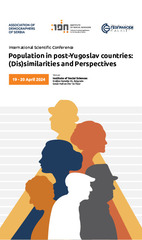Приказ основних података о документу
Changes in the social status of the population in the post-Yugoslav period and the impact on housing in Belgrade
| dc.creator | Ratkaj, Ivan | |
| dc.creator | Jocić, Nikola | |
| dc.creator | Budović, Aljoša | |
| dc.date.accessioned | 2024-04-22T11:16:39Z | |
| dc.date.available | 2024-04-22T11:16:39Z | |
| dc.date.issued | 2024 | |
| dc.identifier.isbn | 978-86-7093-273-9 | |
| dc.identifier.uri | http://gery.gef.bg.ac.rs/handle/123456789/1755 | |
| dc.description.abstract | In the post-socialist period, there were many changes in the post-Yugoslav region. The dissolution of the state and the civil war were just some of the most important events. The successor states went through the post-socialist transition at a different pace. The political and economic transition had a significant impact on the social status of the population. According to numerous international urban studies, there is a causal relationship between the social status of the population and the housing situation. Looking at the social status of the population in Belgrade, it is obvious that the social status decreases from the centre to the periphery. The housing situation in Belgrade is very heterogeneous. First, there is a historical centre filled with buildings from different eras: from the pre-World War II period, from the socialist period and from the post-socialist period. Secondly, there are socialist neighbourhoods that surround the historic core of the city. Finally, there are the neighbourhoods on the periphery, which are mostly informally built. The withdrawal of the state and the reintroduction of market mechanisms in the housing sector, drastic proportions of owner-occupied housing, the expansion of illegal construction activity, international isolation during the 1990s and the subsequent reconnection to the global economy, albeit with extremely weakened institutions, characterised post-socialist housing and urban development in Belgrade. Added to this was another wave of demographic pressure from the former Yugoslav republics and Kosovo. Through the lens of social status and housing situation, we observe the patterns of residential segregation in the post-socialist period. Due to the incomparability of statistical data from different periods, we use a combination of sources and research approaches. The first two decades of the post-socialist period were analysed at the level of census units, using data on the education of the population as a proxy for their social status. | sr |
| dc.language.iso | en | sr |
| dc.publisher | Belgrade : Institute of Social Sciences | sr |
| dc.relation | info:eu-repo/grantAgreement/MESTD/inst-2020/200091/RS// | sr |
| dc.rights | openAccess | sr |
| dc.rights.uri | https://creativecommons.org/licenses/by/4.0/ | |
| dc.source | Book of abstracts of the International Scientific Conference "Population in Post-Yugoslav Countries: (Dis)Similarities and Perspectives", Belgrade | sr |
| dc.subject | Belgrade | sr |
| dc.subject | gentrification | sr |
| dc.subject | housing | sr |
| dc.subject | residential segregation | sr |
| dc.subject | social status | sr |
| dc.title | Changes in the social status of the population in the post-Yugoslav period and the impact on housing in Belgrade | sr |
| dc.type | conferenceObject | sr |
| dc.rights.license | BY | sr |
| dc.citation.spage | 58 | |
| dc.identifier.doi | 10.59954/PPYCDSP2024.30 | |
| dc.identifier.fulltext | http://gery.gef.bg.ac.rs/bitstream/id/4782/bitstream_4782.pdf | |
| dc.type.version | publishedVersion | sr |


